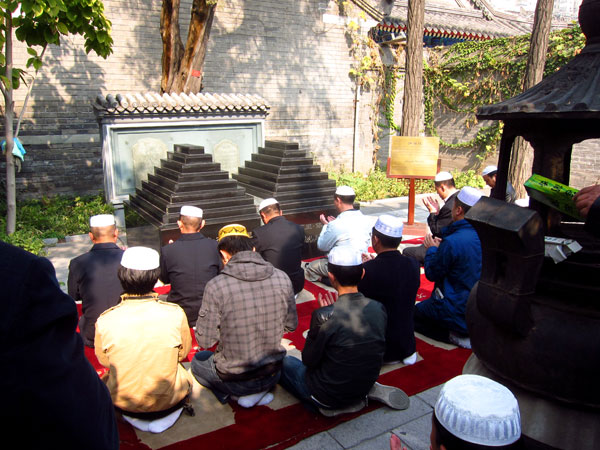Niujie Mosque: Praying on Ox Street
 0 Comment(s)
0 Comment(s) Print
Print E-mail CRI, October 25, 2012
E-mail CRI, October 25, 2012
|
Muslims pray at Niujie Mosque's Shaykh Tombs. |
Niujie (or Ox Street) is the pulsating heart of Beijing's Muslim community, and Niujie Mosque is its buzzing focal point. From the street level, the mosque itself is easy to miss, but more often than not, the Islamic songs emanating from within clearly mark its presence.
Only the Moon-Watching Tower is visible from the outside, almost boxed in by a screen wall between it and the road. Mosque leaders would study moon phases to determine the exact dates of the Ramadan fast.
Within the adjacent front gate is a bustling community of Muslims. Although the prayer hall is the obvious locus, the central courtyard is more of a social gathering point. Bound in by stele pavilions, the minaret and the prayer hall, it is a sunny spot where men, women and children sit and chat with other community members.
As scheduled prayer times near, Muslims shed their shoes and file into the 760 square meter hall. Seating areas on the rows of carpet are soon occupied by cross-legged and kneeling men. (According to tradition, women sit in a separate hall, nearby.) Even before the hall is full, some people choose to sit on carpets unrolled in the courtyard itself.
The main prayer hall is open to Muslims only, but visitors are free to peek in from the doorways. Eventually a Sheikh man takes to the podium to read and discuss the Quran. His amplified voice swells through the entire compound, reaching its farthest corners.
The prayer hall houses the most obvious examples of Kangxi style from the Qing Dynasty, such as the ceiling assembled from colorful painted circles framed within square panels. Islamic influences are evident in the sculpted archways and Arabic calligraphy.
"Usually around 2000 people [a day] come here," said Feng Guoqian, a volunteer of 4 years, "but sometimes the number can reach 20,000." If Feng's statistics prove to be correct, on Muslim special occasions such as the end of the Ramadan fast, or Eid-al-Adha, visitors can expect the mosque to be bursting at the seams with songs and prayer. Eid-al-Adha is a day to celebrate Abraham's willingness to sacrifice his own son for God. Thankfully, in the end God decided that he would let Abraham sacrifice a sheep instead.
Tucked in just past the minaret is where the Shaykh Tombs are located. Around 1270 CE, two Muslim saints came to China to spread Islam, and today their original tombstones and remains are on site. Far from being forgotten, people come daily to pray and pay respect to these two men who helped establish Islam in Beijing.
The feeling in Niujie is very welcoming, and regular attendees shrug and accept the fact that cameras are often present in their place of worship.
"Most of the regulars are Muslims. Non-Muslims just come to visit," said Feng, before noting that a number of visiting foreigners also come to pray. "I met some of them, and we became friends," he added with a broad grin.
Entrance fee: 10 yuan
Hours: 8:30am to 4:30pm daily.
Getting to Niujie Mosque:
From Changchunjie subway station, walk 1.5 kilometers south to the mosque, or from subway exit A, take bus #10 to Niujielibaisi.







Go to Forum >>0 Comment(s)